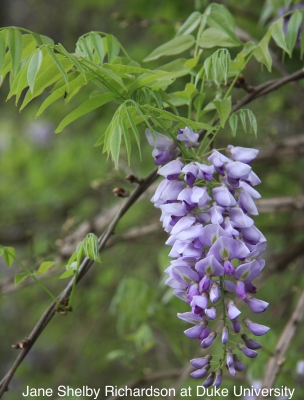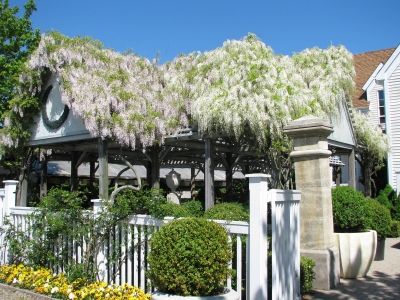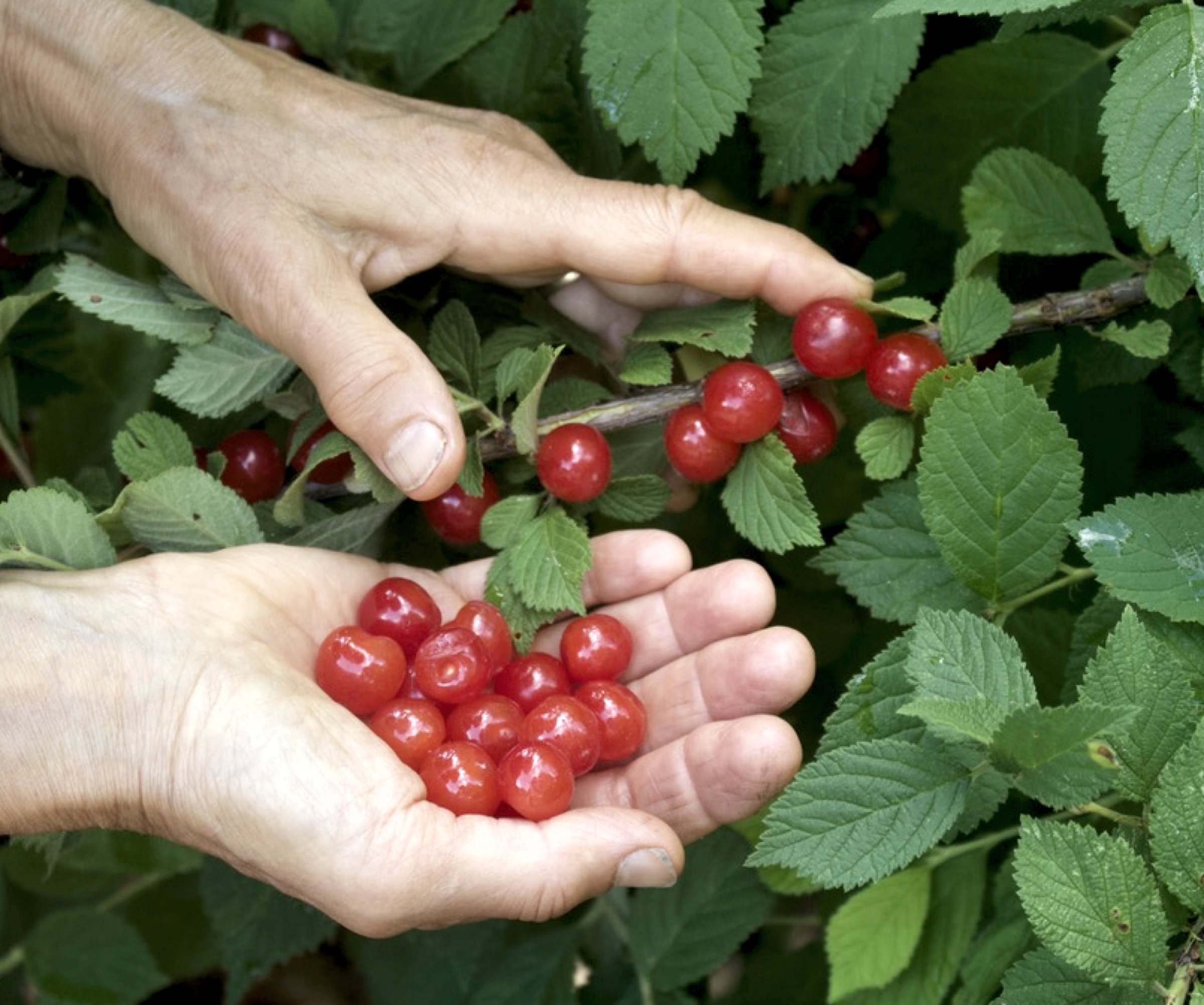WISTERIA UPS AND DOWNS
Shoots vs. Flowers
Around this time of year, few plants are as dramatically beautiful as a well-grown wisteria, whose chains of lavender flowers drip like little waterfalls from the branches. I’ve always wanted one, and now I have one.  But I’ll keep in mind a common complaint people have with wisteria: The frustration when a wisteria plant is all shoots and no flowers!
But I’ll keep in mind a common complaint people have with wisteria: The frustration when a wisteria plant is all shoots and no flowers!
This problem has some causes and some solutions. The common complaint can often be traced to something as simple as a poor plant or a poor site. Perhaps a wisteria plant is not getting sufficient light, which is six or more hours of direct sunlight.
Wisterias propagated from seed have to be mature enough to bloom. The stage from juvenility to maturity, bringing it to reproductive (flowering) age, can take years. A clonally propagated plant — that is, one with a variety name and propagated from mature wood by a graft, a cutting, or layering — will bloom much sooner.
In occasional years, Ol’ Man Winter snatches away blossoms, killing flower buds even before they open. When this is the case, plump (though dead) flower buds are evident on the plant as it goes into spring. Species of wisteria differ in their ability to face up to that winter cold, Japanese wisteria (Wisteria floribunda) is more cold-hardy, and has more fragrant blossoms on longer chains, than Chinese wisteria (W. sinensis). Years ago I planted a native wisteria, variously known as American wisteria or Kentucky wisteria (W. frutescens). It grew fine its first season, and was stone dead the next spring. It was supposed to be cold hardy here in Hardiness Zone 5.

Wisteria frutesens
Wisteria have a tendency to channel their energy into rampant shoot growth at the expense of blossoms. This problem can be exacerbated if you unknowingly lavish care on your wisteria plant in the form of heavy fertilization and winter pruning. Response of wisteria to such treatment — no matter what your intentions — is to send out yet more lanky, flowerless shoots. This type of growth is acceptable only for a young plant still filling its allotted space on a pergola, a fence, or a wall.
Slowing down shoot growth brings an overly enthusiastic wisteria into a blooming habit. Wisteria’s far-reaching roots are well able to seek water and nutrients, so the plan here is to keep a plant on a lean regimen of fertilizer and water. Pruning the roots by thrusting a shovel into the ground all around the plant two to four feet from the trunk further checks growth.
Pruning Detail
Pruning a wisteria in summer ekes the maximum amount of blossoms from a plant (and keeps it tidy). Ideally, a wisteria vine has been trained to a permanent framework consisting of a trunk with a few permanent arms; summer pruning is directed at side shoots that grow off the arms. (An old plant might need ruthless pruning one winter to bring this framework into view out of the tangled mass of vines.)
The goal in summer pruning is to make side shoots into short “handles” on which to hang the drooping blossom clusters. Do this by cutting off the end of each side shoot as soon as its sixth leaf has unfolded.
Wisteria’s enthusiasm is not so easily quelled, and the plant will push out new growth. Cut it back to two leaves. In winter, go back over all side shoots and shorten them to a couple of inches.
Extension growth from the ends of permanent arms should be treated just like side shoots once arms fill their allotted space.
There are other versions of wisteria pruning: pinching out the tips of all side shoots a few times during the growing season; cutting side shoots monthly back to two or three buds; or, shortening side shoots in July to six inches.
I write about pruning wisteria in my book, THE PRUNING BOOK. I also added, in that section, that If you’re disinclined to pay attention to your wisteria vine once bloom is past, and are willing to sacrifice some bloom, follow the advice written in 1927 by Liberty Hyde Bailey in his Standard Cyclopaedia of Horticulture: “There are several ideas about training wisteria. A good way is to let it alone. This produces rugged, twisted, and picturesque branches and gives a certain oriental effect, but is not the best method for covering a wall-space solidly or for making the best display of bloom.” True, but you do have to start with a good plant and a good site, and put the brakes on fertilization and watering.
Wisteria, No, Yes?
All of which I planned to do with my recently acquired wisteria plant, the Japanese wisteria variety Anwen. But wait! I’ve seen wisteria tear down arbors and threaten to engulf homes. Not only that; it also sends up underground runners many feet from the mother plant. I’ve grown afraid of planting it; experience with bamboo and crocosmia have hardened me to potentially invasive plants, especially with the naturally rich soil here.
It turns out that the native American wisteria is much less invasive than either Asian species. Not only is its growth more sedate; also, it blooms on new shoots of the season so can be pruned back more aggressively to coax growth of new, flowering shoots.
I recently learned that Kentucky wisteria is actually a variant of American wisteria, and is sometimes considered a separate species, W. macrostachya.

Kentucky wisteria
Kentucky wisteria is the hardiest of wisterias, to Zone 3, which means my long gone plant was probably not the variant. I might give Kentucky wisteria — the variety Blue Moon, which can bloom three times a season — another try.




This is great information. I was tempted to buy ‘blue moon’ at a plant sale–but then I smelled it. I found it very unpleasant, somewhat like boxwood. Let me know if you find a non-invasive American wisteria that smells great.
A variety of Wisteria frutescens perhaps. I’ve never smelled it — or Blue Moon. But I like the smell of boxwood.
Our twenty five year old wisteria is now, from being full of flowers at this time, now has dwindled to five. Putting out hardly any new shoots last year, so not much left to prune. Is this a case of now replacing the plant, or is there a way of reviving it.
Thanks
It should not have declined. They are generally very long lived. I would try to find out the cause of the decline.
i planted my wisteria years ago so it would grow over my swing. unfortunately I didn’t know it needed lots of sun
only green, no flowers.
can I transplant?
You probably can transplant it. Do it in the fall and dig a good sized root ball.
Hi, I’m in the UK, I have a 35 year old wisteria grown over a gazebo, it has flowered magnificently every year for over 20 years, this year however, the flowers were very small & stunted, barely any leaves yet and it appears to be dying back, is there any way to find out the cause if it’s sudden decline? Thanks in advance
I haven’t looked into this but I never heard of a problem with wisteria dying back. Usually the problem is how to kill it to prevent takeover of a property. Perhaps things are different on your side of the pond.
I have a gorgeous, full North American wisteria in my community garden plot – it’s at least a few years old and has bloomed gorgeously since I took over two years ago. I moved it a few feet a few days ago so I could trellis it against a fence. It was surrounded by rocks and I couldn’t get a good root ball, now it’s looking a bit slumped and I’m worried I’ve made a big mistake. Can wisteria be moved at this time of year without a good root ball? I’m watering daily and trying to keep it supported.
It could be moved, or not, depending on the size of the root ball, the weather, and the age of the plant. Frequent watering is good unless the soil doesn’t drain well.
It is late April and no real problems with hard frost. I bought my wisteria a year ago. It had flowers. A year later it is coming into flower but something is taking little bites on the thin leaf and flower stems, causing them to droop an drop off. Any ideas what this might be?
No, but spy on it a few times at various hours. Check you just what kind of damage is being inflicted. Then write back with a description of the damage.
We have a wisteria that used to grow up the legs of our gazebo and cover the top. My wife was supposed to only trim the overhanging branches but in a drunken attempt she actually cut it almost to the ground completely killing everything on top of the gazebo. Will it grow back or is it finished?
It will grow back. It’s very hard to kill wisteria.